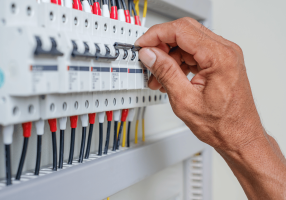Smoke alarms are essential devices that save lives. They are your first line of defence in detecting fires and providing early warnings to help protect your family and property. However, for these devices to perform effectively, proper installation and maintenance are crucial.
This guide covers everything homeowners need to know about smoke alarm types, smoke alarm installation, and maintenance, ensuring you stay compliant with safety regulations and keep your home secure.
If you need help with smoke alarm installation and maintenance, the professional team at Intelli-Gen Electrical is here to assist. Contact us for expert advice and services tailored to your needs.
Why Are Smoke Alarms Important?
Smoke alarms are designed to detect fires in their early stages, giving you precious time to evacuate safely. Without them, smoke inhalation or fire damage can escalate quickly. These devices are mandatory in homes across Australia, and understanding their types and proper care can make a significant difference in their effectiveness.
Types of Smoke Alarms
Choosing the right smoke alarm for your home depends on your specific needs and local regulations. Here are the most common smoke alarm types:
1. Ionisation Smoke Alarms
These alarms are best for detecting fast-flaming fires, such as those caused by paper or grease. However, they are less effective at sensing slow-smouldering fires.
Best For: Kitchens, living areas
2. Photoelectric Smoke Alarms
Photoelectric alarms are highly effective at detecting slow-smouldering fires, such as those caused by overheated wires or cigarettes.
Best For: Bedrooms, hallways
3. Dual-Sensor Smoke Alarms
Combining the technology of ionisation and photoelectric alarms, dual-sensor alarms provide comprehensive protection.
Best For: General home use
4. Interconnected Smoke Alarms
Modern systems allow smoke alarms to communicate with each other. If one alarm detects smoke, all alarms in the system are triggered.
Best For: Larger homes or multi-level properties
5. Hardwired vs. Battery-Powered Smoke Alarms
Hardwired Alarms: Connected directly to your home’s electrical system, often with a backup battery.
Battery-Powered Alarms: Operate independently and are easier to install but require regular battery checks.
Smoke Alarm Installation and Maintenance
Installation Tips
Proper installation ensures your smoke alarms can perform at their best. Here’s what you need to know:
- Placement Matters: Install alarms on the ceiling or high on walls as smoke rises.
Place alarms in every bedroom, outside sleeping areas, and on every level of your home. - Follow Local Regulations: Compliance with Australian safety standards is critical. Always check state or territory-specific requirements.
- Hire a Professional: While some smoke alarms are DIY-friendly, professional installation ensures optimal positioning and proper wiring. Intelli-Gen Electrical offers reliable smoke alarm installation and maintenance services to give you peace of mind.
Smoke Alarm Maintenance
Proper maintenance keeps your smoke alarms in working order and ensures compliance with safety standards. Here’s how to care for your devices:
- Test Alarms Monthly: Press the test button to ensure the alarm sounds.
- Replace Batteries Annually: For battery-powered alarms, replace the batteries at least once a year.
- Clean Alarms Regularly: Dust and debris can interfere with the sensors. Use a vacuum or soft cloth to clean the exterior every few months.
- Replace Units as Needed: Smoke alarms have a lifespan of about 10 years. Check the manufacturer’s instructions for replacement timelines.
- Conduct Annual Inspections: Professional inspections can identify hidden issues, ensuring your smoke alarms remain fully functional.
Common Smoke Alarm Issues and How to Fix Them
- False Alarms: Dust, steam, or cooking fumes can trigger false alarms. Clean the alarm and reposition it away from kitchens or bathrooms if necessary.
- Chirping Sounds: A chirping alarm typically indicates a low battery or the need for replacement. Change the battery or consult a professional if the issue persists.
- No Response During Testing: If the test button doesn’t work, the unit may be faulty or nearing the end of its life. Replace it promptly.
Legal Requirements for Smoke Alarms in Australia
Every state and territory in Australia has specific requirements for smoke alarms, such as the type, location, and power source. Here are some key regulations:
- All homes must have working smoke alarms installed.
- New builds and renovations often require hardwired, interconnected smoke alarms.
- Battery-powered alarms must comply with Australian standards.
Failing to meet these requirements can result in fines or increased liability in case of an incident.
Why Choose Intelli-Gen Electrical for Your Smoke Alarm Needs?
At Intelli-Gen Electrical, we specialise in smoke alarm installation and maintenance, offering services that prioritise your safety and compliance. Whether you’re upgrading your system or need expert advice on the best smoke alarm types for your home, we’ve got you covered.









